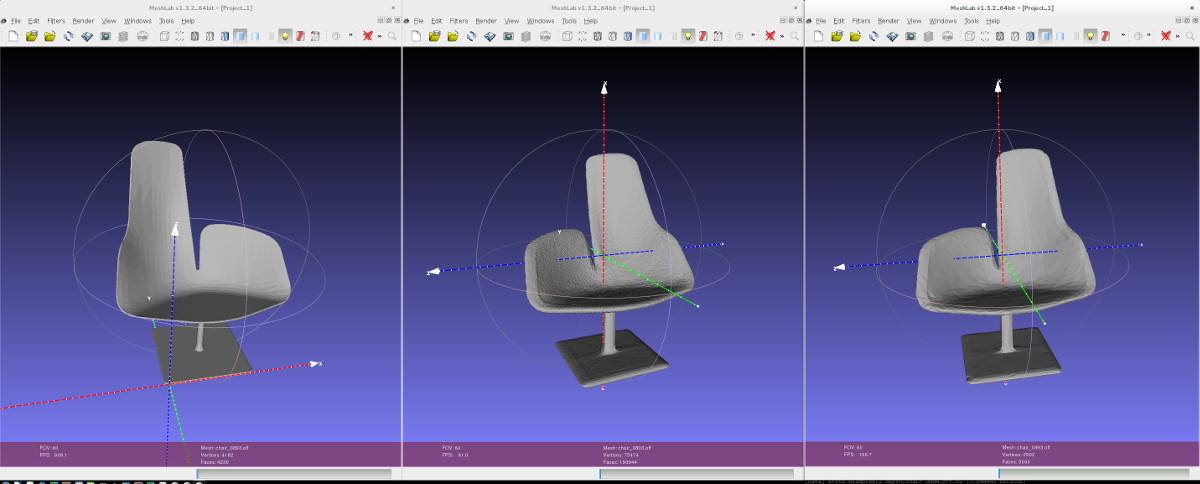This repository contains a simply Python pipeline for obtaining watertight
and simplified meshes from arbitrary triangular meshes, given in .off format.
The approach is largely based on adapted versions of Gernot Riegler's
pyrender and pyfusion;
it also uses PyMCubes.
If you use any of this code, please make sure to cite the following work:
@article{Stutz2018ARXIV,
author = {David Stutz and Andreas Geiger},
title = {Learning 3D Shape Completion under Weak Supervision},
journal = {CoRR},
volume = {abs/1805.07290},
year = {2018},
url = {http://arxiv.org/abs/1805.07290},
}
See the GitHub repositories above for additional citations. Also check the corresponding project page.
The pipeline consists of three steps:
- Scaling using
1_scale.py, which scales the meshes into[-0.5,0.5]^3with optional padding. - Rendering and fusion using
2_fusion.pywhich in a first step renders views of each mesh, and uses these to peform TSDF fusion. - Simplification using MeshLab.
The result is illustrated below; note that the shape gets slightly thicker and the axes change (due to marching cubes).
Update: When using Max, #21 might be helpful before starting with the below.
Update: There are some minor changes necessary for newer MeshLab versions, see #15.
Update: For newer CUDA versions/GPU architectures, the CMAKE file in libfusiongpu needs to be adapted as outlined in this issue.
The pipeline is mostly self-contained, given a working installation of Python. Additionally, it requires MeshLab for simplification.
The used pyfusion library requires
CMake and Cython; optionally it uses CUDA or OpenMP for efficiency.
pyrender requires Cython, as well.
Additionally, it requires OpenGL, GLUT and GLEW, see librender/setup.py
for details. PyMCubes requires Cython.
All three libraries are included in this repository.
For building follow (illustrated for the GPU version):
# build pyfusion
# use libfusioncpu alternatively!
cd libfusiongpu
mkdir build
cd build
cmake ..
make
cd ..
python setup.py build_ext --inplace
cd ..
# build pyrender
cd librender
python setup.py build_ext --inplace
cd ..
# build PyMCubes
cd libmcubes
python setup.py build_ext --inplace
Usage is illustrated on the shipped examples in examples/0_in taken
from ModelNet.
First, scale the models using:
python 1_scale.py --in_dir=examples/0_in/ --out_dir=examples/1_scaled/
Now the models can be rendered, per default, 100 views (uniformly sampled on a sphere) will be used:
2_fusion.py --mode=render --in_dir=examples/1_scaled/ --depth_dir=examples/2_depth/ --out_dir=examples/2_watertight/
The details of rendering can be controlled using the following options:
--n_views N_VIEWS Number of views per model.
--image_height IMAGE_HEIGHT
Depth image height.
--image_width IMAGE_WIDTH
Depth image width.
--focal_length_x FOCAL_LENGTH_X
Focal length in x direction.
--focal_length_y FOCAL_LENGTH_Y
Focal length in y direction.
--principal_point_x PRINCIPAL_POINT_X
Principal point location in x direction.
--principal_point_y PRINCIPAL_POINT_Y
Principal point location in y direction.
--depth_offset_factor DEPTH_OFFSET_FACTOR
The depth maps are offsetted using
depth_offset_factor*voxel_size.
--resolution RESOLUTION
Resolution for fusion.
--truncation_factor TRUNCATION_FACTOR
Truncation for fusion is derived as
truncation_factor*voxel_size.
During rendering, a small offset is added to the depth maps. This is particular important for meshes with thin details, as for example the provided chairs. Essentially, this thickens the structures. In the code, the offset is computed as
voxel_size = 1/resolution
offset = depth_offset_factor*voxel_size
Now, fusion can be run using
python 2_fusion.py --mode=fuse --in_dir=examples/1_scaled/ --depth_dir=examples/2_depth/ --out_dir=examples/2_watertight/
For fusion, the resolution and the truncation factor are most importance.
In practice, the truncation factor may be in the range of [0, ..., 15];
then, the truncation threshold is computed as
voxel_size = 1/resolution
truncation = truncatioN_factor*voxel_size
Note that rendering and fusion is splitted as rendering might not work on all machines, especially remotely (e.g. through ssh) on machines without monitor.
Finally, simplification is performed using meshlabserver; make sure to have
it installed and run
python 3_1_simplify.py --in_dir=examples/2_watertight/ --out_dir=examples/3_out/
The result of all steps is illustrated in the screenshot above.
``pyrender.so'' not found:
For fixing OSError: /home/mona/mesh-fusion/librender/pyrender.so: cannot open shared object file: No such file or directory, see issue #10.
Compiling with new versions of Python/Cython: Follow issue #7.
Using with newer GPUs: See issue #13 for changes required to use the code with newer NVidia GPUS.
License for source code corresponding to:
D. Stutz, A. Geiger. Learning 3D Shape Completion under Weak Supervision. International Journal of Computer Vision (2018).
Note that the source code and/or data is based on the following projects for which separate licenses apply:
Copyright (c) 2018 David Stutz, Max-Planck-Gesellschaft
Please read carefully the following terms and conditions and any accompanying documentation before you download and/or use this software and associated documentation files (the "Software").
The authors hereby grant you a non-exclusive, non-transferable, free of charge right to copy, modify, merge, publish, distribute, and sublicense the Software for the sole purpose of performing non-commercial scientific research, non-commercial education, or non-commercial artistic projects.
Any other use, in particular any use for commercial purposes, is prohibited. This includes, without limitation, incorporation in a commercial product, use in a commercial service, or production of other artefacts for commercial purposes.
THE SOFTWARE IS PROVIDED "AS IS", WITHOUT WARRANTY OF ANY KIND, EXPRESS OR IMPLIED, INCLUDING BUT NOT LIMITED TO THE WARRANTIES OF MERCHANTABILITY, FITNESS FOR A PARTICULAR PURPOSE AND NONINFRINGEMENT. IN NO EVENT SHALL THE AUTHORS OR COPYRIGHT HOLDERS BE LIABLE FOR ANY CLAIM, DAMAGES OR OTHER LIABILITY, WHETHER IN AN ACTION OF CONTRACT, TORT OR OTHERWISE, ARISING FROM, OUT OF OR IN CONNECTION WITH THE SOFTWARE OR THE USE OR OTHER DEALINGS IN THE SOFTWARE.
You understand and agree that the authors are under no obligation to provide either maintenance services, update services, notices of latent defects, or corrections of defects with regard to the Software. The authors nevertheless reserve the right to update, modify, or discontinue the Software at any time.
The above copyright notice and this permission notice shall be included in all copies or substantial portions of the Software. You agree to cite the corresponding papers (see above) in documents and papers that report on research using the Software.
